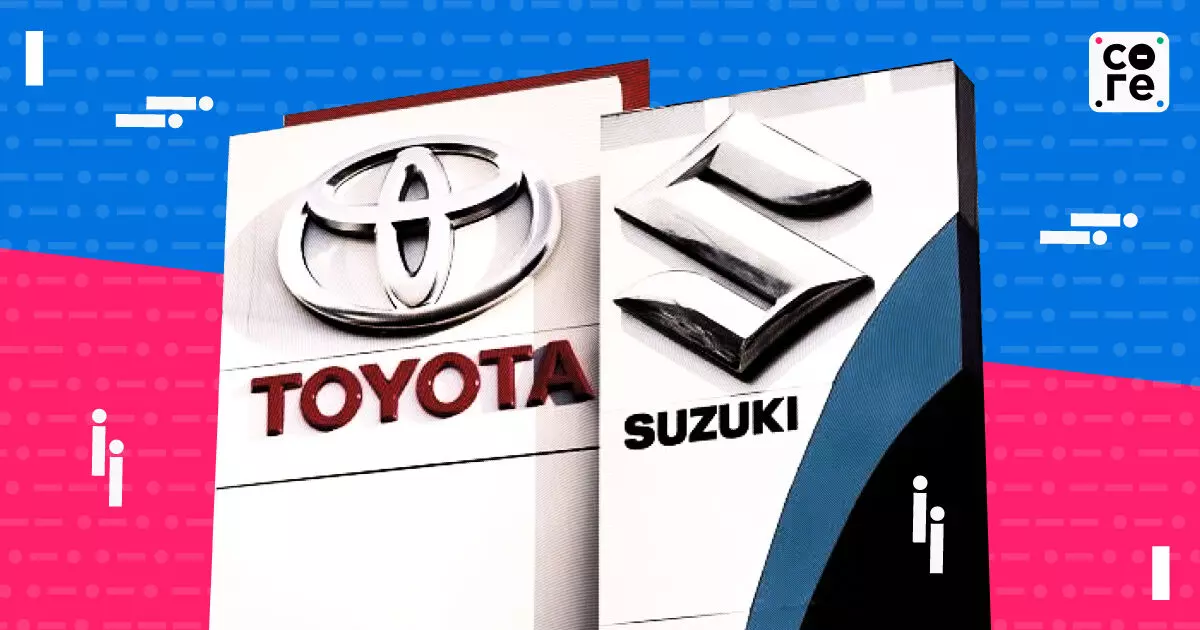Copyright thecore

Japanese automaker Toyota entered in India in a joint venture with the Kirloskar group in 1997, launching the Toyota Qualis in 2000. They came in with global experience and big ambition. Maruti, meanwhile, was already a household name. At the time, buying an entry-level car was almost synonymous with buying a Maruti.For decades, the two brands have carved out different paths in the same country, one dominating the small car and affordable segment with a lion’s share of the market, and the other catering to the premium end, starting with the Qualis and now best known for the Innova and Fortuner.What began as different trajectories has now converged into a partnership in India’s changing automotive landscape.Toyota Motor sold 10.8 million vehicles in 2024, topping global sales for the fifth straight year. But while Toyota once lagged in India, the ongoing Toyota–Suzuki global alliance is quietly proving that in the race toward the future of mobility, teaming up beats doing it alone.How It All Began The global collaboration goes back to 2016, when the top bosses, the late Osamu Suzuki and Akio Toyoda, initiated discussions about joining forces-- a move aimed at steering through disruption and building on each other’s strengths for sustainable growth. “We are aware that the future is full of risks,” Suzuki had said at a joint news conference with Toyoda then. A year later, they made it official with a memorandum of understanding for a business alliance. Since then, the relationship has only gotten deeper as it was tested, tweaked, and expanded into new areas. But the real ‘it’s getting serious’ moment came in 2019, when the two giants put some real skin in the game with an equity investment in each other. That’s when industry watchers became quite sure of a certain future.The alliance plays across several big markets, including India, Europe, Africa, Japan, and the Middle East, but the biggest wins have shown up in India. That’s where the partnership has really flexed its muscles, giving both companies a serious edge in one of the world’s most competitive and fast-changing auto markets.In India, Suzuki operates through Maruti Suzuki, where it holds about 58.3% stake. And India isn’t just another market for Suzuki, it’s the biggest. The country accounted for over 61% of Suzuki’s total output and 57% of global sales last year. Meanwhile, Toyota runs the show through its local arm, Toyota Kirloskar Motor (TKM), and India has quietly climbed the ranks to become Toyota’s third-largest market outside Japan, after the US and China. Together, the two have struck a sweet deal where Suzuki brings the market muscle, while Toyota brings the tech and strategy game. A Tilt In Toyota’s Favour? If you look at the India story, it’s easy to think Toyota is getting the better end of the deal. The company once tried to crack the mass-market code with the Etios, Liva and Yaris. But these models did not stick. Fast forward to today, and things look very different for the carmaker. Through vehicle rebadging-- where one company sells a model developed by the other with only minor cosmetic changes like the logo, grille, bumper-- Toyota is tapping into Suzuki’s expertise in compact car design. The lineup of four rebadged models, including the Glanza (based on Maruti Suzuki Baleno), Urban Cruiser Taisor (Fronx), Urban Cruiser Hyryder (Grand Vitara), and Rumion (Ertiga), contributed about 55% to Toyota’s total sales in India during H1 FY26, up from 53% in FY25 and 44% in FY24. This smart badge engineering lets Toyota tap into cost-effective, high-volume models without diving headfirst into what would otherwise be a capital-intensive exercise. Interestingly, it hasn’t eaten into sales of Maruti’s respective models, likely because of an internal agreement that caps how many cars can be supplied to Toyota. “This strategy has allowed Toyota to enter previously inaccessible segments,” Ammar Master, former director of South Asia- Automotive at GlobalData, told The Core. Thanks to the partnership, Toyota’s market share has jumped from a mere 3% in FY21 to around 8% in FY25, and its factory utilisation has gone up significantly, moving it beyond the larger vehicles tag and giving it real street cred in India’s fiercely competitive car scene. The dealer viability has also improved over the past years. “With portfolio expansion, Toyota dealers deliver much higher profitability compared to market standards,” Amit Kaushik, former managing director at Urban Science India told The Core. The collaboration is also letting Toyota enter categories where it did not exist before, especially the Rs 15 lakh to Rs 30 lakh range that is expected to continue to drive the consumer demand. Toyota’s Indian arm closed FY25 with a record-breaking performance, posting a consolidated net profit of Rs 5,672 crore, that’s up 18.5% from Rs 4,787 crore in FY24. This was the most profitable year in its 25-year history in India, with...



